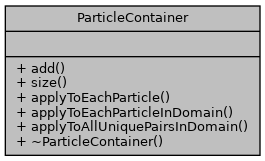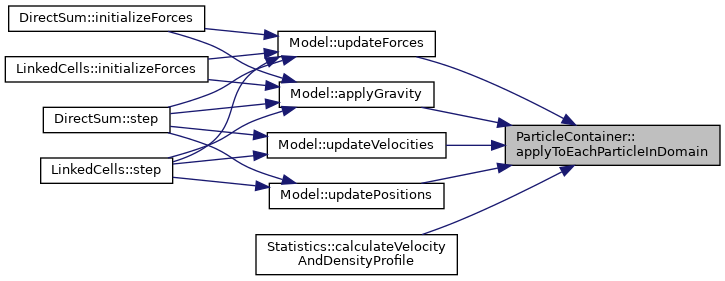#include <ParticleContainer.h>


Public Member Functions | |
| virtual void | add (Particle &p)=0 |
| Add one particle to this container. More... | |
| virtual size_t | size () const =0 |
| Get the number of particles stored in this container. More... | |
| virtual void | applyToEachParticle (const std::function< void(Particle &)> &function)=0 |
| Iterate over all particles in this container and apply a lambda function to them. More... | |
| virtual void | applyToEachParticleInDomain (const std::function< void(Particle &)> &function)=0 |
| Iterate over all particles that are part of the domain and apply a lambda function to them. More... | |
| virtual void | applyToAllUniquePairsInDomain (const std::function< void(Particle &, Particle &)> &function)=0 |
| Iterate over all unique pairs of particles being part of the simulation domain and apply a lambda function to them. More... | |
| virtual | ~ParticleContainer ()=default |
| Virtual default constructor to guarantee appropriate memory clean up. More... | |
Detailed Description
Abstract base class for a particle container. Each type of a particle container should extend this class.
Constructor & Destructor Documentation
◆ ~ParticleContainer()
|
virtualdefault |
Virtual default constructor to guarantee appropriate memory clean up.
Member Function Documentation
◆ add()
|
pure virtual |
Add one particle to this container.
- Parameters
-
p Particle to be added to this container.
Add one particle to this container. It will be appended.
Implemented in LinkedCellsContainer, and DefaultParticleContainer.

◆ applyToAllUniquePairsInDomain()
|
pure virtual |
Iterate over all unique pairs of particles being part of the simulation domain and apply a lambda function to them.
- Parameters
-
function Lambda function that is applied to each unique pair of particles.
The purpose of this function is provide an easy way of calculating the force between all particles by using Newton's third law of motion.
Implemented in LinkedCellsContainer, and DefaultParticleContainer.

◆ applyToEachParticle()
|
pure virtual |
Iterate over all particles in this container and apply a lambda function to them.
- Parameters
-
function Lambda function that is applied to each particle.
Implemented in LinkedCellsContainer, and DefaultParticleContainer.

◆ applyToEachParticleInDomain()
|
pure virtual |
Iterate over all particles that are part of the domain and apply a lambda function to them.
- Parameters
-
function Lambda function that is applied to each particle.
Implemented in LinkedCellsContainer, and DefaultParticleContainer.

◆ size()
|
pure virtual |
Get the number of particles stored in this container.
- Returns
- Number of particles stored in this container.
Implemented in LinkedCellsContainer, and DefaultParticleContainer.

The documentation for this class was generated from the following file:
- /home/runner/work/MolSim/MolSim/src/particleRepresentation/container/ParticleContainer.h